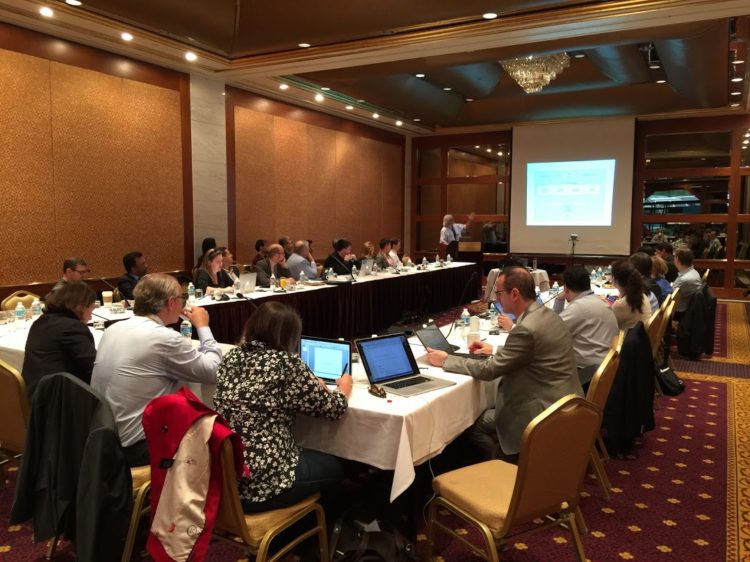
ICT4Peace was again invited by ASG UN Chief Information Technology Officer Ms. Atefeh Riazi to organise again the UN Crisis Information Management Retreat (CIMAG) 2015. The themes of this year’s retreat were as follows:
- An introspection of the UNMEER / UN Ebola response, interrogating in particular the adoption of Crisis Information Management (CiMS) principles to strengthen collaboration and coordination in the response efforts
- A retrospection of CiM efforts of the UN since Haiti 5 years ago, ending with UNMEER, to understand what’s changed and what remain key challenges.
- Moving forward, develop concrete recommendations for the UN top Management on how data and technology can be better leveraged within the UN system and beyond to manage humanitarian crisis such as Ebola.
Approximately 30 Information Management Specialists from the UN Secretariat, UN Organisations responsible for Peacekeeping, Peacebuilding and Humanitarian Operations participated on 8 and 9 June in Manhattan New York Meeting (UN OICT, OCHA, WHO, DPKO/DFS, UNDP, UNICEF, World Bank,UNOSAT, UNMEER, UNHCR, UN OCC, UN DPA, UN DPI, UN Global Pulse).
The Agenda of the Meeting can be found here. More photos from the retreat can be seen here.
Two top UN officials responsible for managing the Ebola crisis participated in the meeting: Under-Secretary General, Dr. David Nabarro, Special UN Envoy for Ebola and Under-Secretary General and Special Representative for United Nations Mission for Ebola Emergency Response (UNMEER) Peter Jan Graaf. A number of concrete recommendations for improving Crisis Information Management in crisis of this nature were developed.
The meeting was made possible thanks to the generous financial support by the Government of Sweden and UN OICT. Swedish Ambassador Per Thöresson opened the meeting and participated in the discussions.
###
Some Background Information o the UN Crisis Information Management Strategy and CiMAG:
The 2010 Report of the Secretary-General (A/65/491) on the Status of implementation of the information and communications technology strategy for the United Nations Secretariat, prominently underscores the Crisis Information Management (CiM) Strategy, Under the section ‘United Nations system-wide harmonization efforts’, the report notes (Pg. 38):
“Crisis information management strategy. The Crisis Information Management Strategy is based on the recognition that the United Nations, its Member States, constituent agencies and non-governmental organizations need to improve such information management capacity in the identification, prevention, mitigation, response and recovery of all types of crises, natural as well as man-made. The strategy will leverage and enhance this capacity and provide mechanisms to integrate and share information across the United Nations system. The Office of Information and Communications Technology, together with the Office for the Coordination of Humanitarian Affairs, the Department of Peacekeeping Operations and the Department of Field Support, has worked closely with United Nations organizations such as the Office of the United Nations High Commissioner for Refugees (UNHCR), the United Nations Children’s Fund (UNICEF), the United Nations Development Programme (UNDP) and WFP and other entities such as the ICT for Peace Foundation in developing and implementing this strategy. It is envisaged that membership will be expanded to include other United Nations organizations in the near future.”
In December 2014, the UN General Assembly approved the update of the UN Secretary-General’s Strategy, to better exploit the enormous potential of Information and Communications Technologies (ICT) for decision-making and delivery capacity of the United Nations in the areas of peace and security, humanitarian operations and development, human rights and international law. The strategy is contained in the SG’s report of 10 October 2014 on Information and Communication Technology in the United Nations (A/69/517). The report mentions: “The (UN) Office of Information and Communications Technology will explore opportunities to develop capacity in analytics and potential means of collaboration with other United Nations entities throughout the global ICT community on the development of analytics solutions to allow for operational flexibility in support of the delivery of their mandates. Analytics could assist in crisis management efforts and the Office would seek to work with the Crisis Information Management Advisory Group (CiMAG) to seek to explore this further.”
Subsequently, the General Assembly in its resolution dated 26 December 2014 (A/C.5/69/L.26*) welcomed the new Information and Communications Technology Strategy in the United Nations, as contained in the report of the Secretary-General, and requested him to provide, in 2015, detailed information on the implementation of all the elements of the proposed new strategy.
Annex I: Members of CiMAG include inter alia: UN CITO, Office of SG, OCHA, DPKO, DFS, DPA, UNHCR, WFP, OHCHR, UNDP, UNICEF, DSS, UNFPA, PBSO, ICT4Peace.
Annex II: Reports on the CiMAG Retreats of previous years are to be found below:
- Report of Crisis Information Management Advisory Group (CiMAG) Retreat 2014
- Report of Crisis Information Management Advisory Group (CiMAG) Retreat 2013
- Report of the Crisis Information Management CiMAG Retreat 2012
- UN Crisis Information Management Advisory Group (CiMAG) Meeting 2011
- UN Crisis Information Management Advisory Group meeting 2010
- UN CiMAG Retreat 2010
